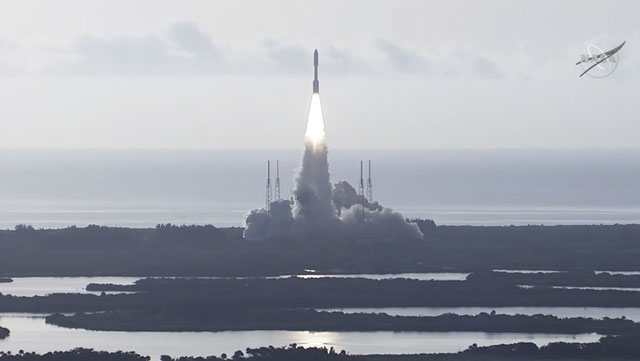
Florida, USA | XINHUA | NASA has launched its Mars rover Perseverance in a bid to search for signs of ancient life on the Red Planet.
The rover lifted off at 7:50 a.m. EDT (1150 GMT Thursay) on a United Launch Alliance Atlas V rocket from Space Launch Complex 41 at Cape Canaveral Air Force Station in the U.S. state of Florida.
NASA confirmed the separation of the rover from the rocket about one hour following the launch.
“The @NASAPersevere rover just sent its first signal back to us on Earth. The spacecraft is in good health and on its way to Mars,” NASA Administrator Jim Bridenstine tweeted.
“We had a good launch this morning, we’re right on course for Mars and signal from @NASAPerseverence is strong. We are working to configure the ground stations to match the strength of the spacecraft signal. This scenario is one we’ve worked through in the past with other missions,” Bridenstine tweeted.
Following a seven-month journey, the rover is expected to land at Jezero Crater on Mars on Feb. 18, 2021. The 45-kilometer-wide crater was a possible oasis in its distant past, a place with high potential for finding signs of past microbial life, according to NASA.
Update on @NASAPersevere: We have received telemetry (detailed spacecraft data) down from the spacecraft and have also been able to send commands up to the spacecraft. Perseverance is healthy and on its way to Mars. https://t.co/U6dAazpEBp
— Jim Bridenstine (@JimBridenstine) July 30, 2020
Perseverance is the fifth Mars rover sent by NASA to Mars, after Sojourner, Spirit, Opportunity, and Curiosity. It is also the largest and heaviest robotic Mars rover NASA has built.
The rover will search for signs of ancient microbial life, characterize the planet’s geology and climate, collect carefully selected and documented rock and sediment samples for a possible return to Earth, and pave the way for human exploration beyond the Moon, according to NASA.
Perseverance is the first rover to bring a sample caching system to Mars that will package promising samples for return to Earth by a future mission.
Perseverance’s drill will cut intact rock cores that are about the size of a piece of chalk and will place them in sample tubes that it will store until the rover reaches an appropriate drop-off location.
The Mars sample return campaign is being planned by NASA and the European Space Agency to investigate the samples with instruments too large and complex to send to Mars. Examining those samples on Earth will provide far more information about them than even the most sophisticated rover could provide, said NASA.
“In 2026, we’re going to launch a mission from Earth to Mars to go pick up those samples and bring them back to Earth,” Bridenstine said. “For the first time in history, we’re doing a Mars sample return mission.”
Perseverance will also be collecting important data about Mars’ geology and climate. Studying the Red Planet’s geology and climate could also offer a sense of why Earth and Mars — which formed from the same primordial stuff — ended up so different, said NASA.
Perseverance also ferries a 1.8-kg helicopter to the surface of Mars, and the helicopter would be the first aircraft to fly in a controlled way on another planet.
The twin-rotor, solar-powered helicopter, Ingenuity, is intended to demonstrate technologies needed for flying in the Martian atmosphere. If successful, these technologies could enable other advanced robotic flying vehicles that might be included in the future robotic and human missions to Mars, said NASA.
In a spirit of bringing the public along, the Perseverance rover carries an anodized plate with the words “Explore as one” in Morse code and three silicon chips with the names of approximately 10.9 million people who signed up to ride along on Perseverance’s journey to Mars.
The Perseverance mission is part of a larger program that includes missions to the Moon as a way to prepare for human exploration of the Red Planet.
Charged with returning astronauts to the Moon by 2024, NASA will establish a sustained human presence on and around the Moon by 2028 through NASA’s Artemis lunar exploration plans.
Every 26 months, Mars reaches the closest point to Earth in its orbit, and this summer is the latest launch window to the Red Planet, when launching a spacecraft uses the least amount of fuel.
The liftoff of Perseverance is the third Mars exploration of the international community this year following China’s first Mars mission, Tianwen-1, and the first Mars orbiter of the United Arab Emirates earlier this month.
XINHUA
 The Independent Uganda: You get the Truth we Pay the Price
The Independent Uganda: You get the Truth we Pay the Price


